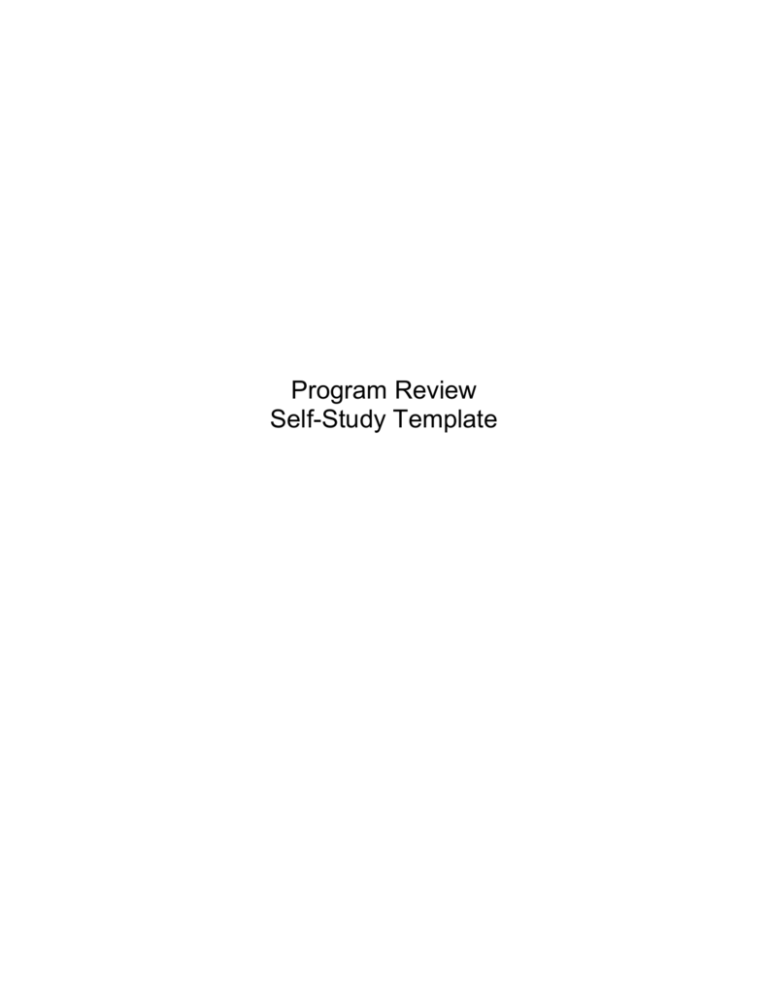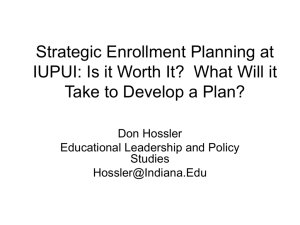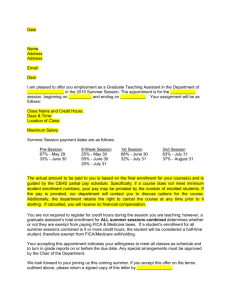Self-Study
advertisement

Program Review Self-Study Template Program Review Self-Study—Annotated Table of Contents Program Vision, Mission, and Values [Include program vision, mission, and values statements and discuss relationship to College, University, and SUS vision, mission and values.] Program Goals and Objectives—Statements [Identify program goals and objectives for each mission element below and discuss their relationship to College, Academic Affairs, University, and SUS goals and objectives.] Instruction/Learning Scholarship and Creative Activity Service Other Program Goals and Objectives—Assessment and Related Actions (Methodology and Use of Data) [Provide information about the assessment procedures and assessment results for the goals and objectives identified above; describe actions taken or planned based on assessment results.] Instruction/Learning Scholarship and Creative Activity Service Other Review of Curriculum [Describe the curriculum; discuss relevancy and currency of the curriculum and recommended changes; ensure that course syllabi are posted to SACS Faculty Academic Credentials website.] Review of Common Prerequisites (bachelor’s degree programs only) [Identify common prerequisites; discuss needed changes to the common perquisites and rationale for proposed changes.] Review of Limited Access Status (bachelor’s degree programs only) [If the program has limited access status, provide rationale for continuing the limited access status.] Articulation Within and Outside the University [Describe articulation activities with related programs at UWF, with other higher education institutions (e.g., community colleges, state colleges), and with public schools.] Enrollment, Retention, and Degree Productivity [Discuss trends identified in five-year summary tables and graphs with respect to future viability of the program; discuss projections for employment opportunities for program graduates.] Programs and Services Associated with the Degree Programs [Include information about related centers/institutes, grants/contracts, certificate programs, community/professional service, and so forth.] Resources—Trends and Projection of Need [Discuss trends identified in five-year summary tables and graphs; identify and provide rationale for additional resource needs.] Income Generated Expenditures Personnel Faculty [Updated vitae are to be posted to SACS Faculty Academic Credentials website] Staff Other Library and Other Learning Resources Information Technology Physical Equipment Facilities Other Summary of Major Changes Subsequent to Previous Program Review [Describe major changes to the program and program operations since the previous review; identify changes made in response to recommendations from the previous review.] Strengths, Weaknesses, and Opportunities Current Strengths of the Program Current Weakness of the Program Opportunities Threats to Program Viability Recommendations/Proposed Action Plans Assessment Summary: UWF Program Evaluation Matrix [This Matrix is used by UWF program personnel as part of the Self-Study and will also be used by the Program Review Team] Appendices [As noted, plus other appendices appropriate to the review] Student Learning Outcomes Academic Learning Compact(s)/Academic Learning Plan(s) Assessment Plan(s) Enrollment Trend Data Headcount Full Time Equivalent Retention Data Degree Productivity Trend Data Resource Data Income Generation Data Expenditure Trend Data Personnel Trend Data Library and Other Learning Resources Data Information Technology Data Special Facilities Special Equipment Grant/Contract Acquisition Summary Community Engagement/Professional Service Summary Certificate Programs Summary Program Review Team/Accreditation Review Team Program Review Site Visit Schedule/Accreditation Review Site Visit Schedule UWF Program Evaluation Matrix for__________________________________________________________________ Insert numerical Program Self-Ratings and Program Review Team (PRT) ratings in the two right-most columns. Explanatory comments (if any) may be inserted in the table following the ratings table. Characteristic 1. MISSION FIT How well does the unit address objectives outlined in the mission statement? Indicators: • meets regional need • fills national niche 2. EDUCATIONAL QUALITY How well does the unit achieve high caliber educational impact? Indicators: • assessment results • national exam status • NSSE engagement results • student competition awards • program review findings 3. ASSESSMENT PLANNING How sophisticated is the department’s assessment effort? Indicators: • department meeting minutes • annual report • SOTL scholarship • external reviews Distinguished 4 Best practice Attains status of signature unit that symbolizes UWF’s unique goals and contributions (especially as compared to other SUS members and regional higher ed institutions) Demonstrates exemplary performance and impact through multiple, sturdy benchmarks Excellent 3 Solid performance Signifies unit that is explicitly tied to mission but hasn’t reached the stature of a signature unit Adequate 2 Minor problems Signifies unit that is implicitly tied to mission Insufficient 1 Major problems Signifies unit that has no apparent link to mission Demonstrates strong performance and impact through more limited benchmarks Demonstrates moderate achievements in performance and impact benchmarks Demonstrates minor or no achievements in performance and impact benchmarks Embraces mature assessment planning and disseminates SOTL scholarship to establish leadership in the discipline Reflects maturity in approach by including full assessment cycle, continuous improvement, questions and broad involvement from all/vast majority of department members Reflects two of three elements of mature assessment plan Reflects one or no elements of mature assessment plan Program Self-Rating PRT Rating Characteristic 4. OPERATIONAL QUALITY How well does the unit fulfill campus citizen obligations? Indicators • deadline responsiveness • resource generation • leadership contributions • assessment responsiveness • appropriate resource use • outreach practices • graduation participation 5. STRATEGIC PLANNING How effectively does the department engage in longand short-term planning? Indicators: • department meeting minutes • annual report • chair supervision • CCR rationales 6. FACULTY QUALITY How prominent have the faculty become in their teaching, research, and service contributions? Indicators • peer review results • faculty awards/ recognition • scholarly & creative productivity measures • citation impact indices Distinguished 4 Best practice Meets obligations efficiently and effectively with full participation of unit members; members makes significant contributions from individual strengths; problem-solving tends to be proactive Demonstrates broad constituent collaboration on formation of SMART (specific, measurable, appropriate, realistic, and timely) goals and their pursuit Excellent 3 Solid performance Meets obligations efficiently and effectively but work load tends to be born disproportionately by more committed unit members; problemsolving tends to be responsive Adequate 2 Minor problems Meets obligations but may struggle with efficiency, effectiveness, or equitable work load distribution; problemsolving tends to be reactive Insufficient 1 Major problems Fails or is inconsistent in meeting obligations efficiently and effectively; the work load may be inequitably distributed; problem-solving tends to be protracted, disorganized, or avoided Demonstrates limited collaboration on SMART goals and their pursuit Submits goals that show minor problems in SMART goal formulation Submits goals that show major problems in SMART goal formulation Achieves national or international prominence based on recognition of exemplary individual performance by majority of unit faculty Achieves regional/local prominence based on accumulated individual performance by unit faculty Achieves local reputation for functionality but not prominence based on accumulated individual performance by unit faculty Fails to achieve prominence; reputed to have questionable quality based on accumulated individual performance by unit faculty Program Self-Rating PRT Rating Characteristic 7. COST RECOVERY How effective is the unit in generating cost recovery through SCH? This indicator will be provided, calculated as income-cost. 8. ENROLLMENT HISTORY What do enrollment patterns suggest about unit capacity over past 3 years? Indicators • 3 year SCH patterns • retention statistics 9. MARKET PROJECTIONS What are the prospects for enrollment growth for the next 5 years? Indicators • Workforce projections • Disciplinary society estimates • Job placement rates for grads Distinguished 4 Best practice Contributes significant profit margin over cost recovery to help with university overhead Excellent 3 Solid performance Contributes moderate profit margin over cost recovery to help with university overhead Adequate 2 Minor problems Breaks even on cost recovery Insufficient 1 Major problems Fails to break even on cost recovery Experiences steady progress dramatic growth in enrollments linked to strong market demand and/or innovative ways of meeting enrollment management demands Graduates are in significant demand; Future enrollments are ensured at high levels because applications are competitive Experiences steady growth in enrollment linked to favorable market demand and/or effective enrollment management strategies Experiences flat or irregular enrollment linked to more variable market demand and /or limited enrollment management practices Shows irregular or declining enrollments linked to reduced market demand and/or inactivity in enrollment management Graduates are in demand; Future enrollments projected to be strong and steady Graduates land jobs; Future enrollments expected to remain stable Graduates have difficulty getting jobs after graduation; Future enrollments hard to project or likely to decline TOTALS Program Self-Rating PRT Rating Rating Explanatory Comments (if any) Note: Comment sections will expand to fit text. Characteristic Comments Program: 1. Mission Fit Program Review Team: Program: 2. Educational Quality Program Review Team: Program: 3. Assessment Planning Program Review Team: Program: 4. Operational Quality Program Review Team: Program: 5. Strategic Planning Program Review Team: Program: 6. Faculty Quality Program Review Team: Program: 7. Cost Recovery Program Review Team: Program: 8. Enrollment History Program Review Team: Program: 9. Market Projections Program Review Team:





